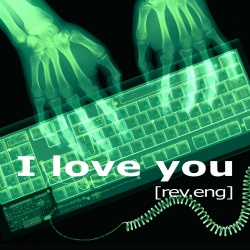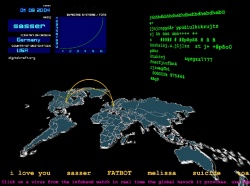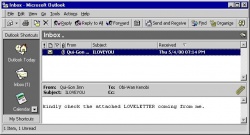I Love You [rev.eng]
01. Sep. 2004

The title of the exhibition is identical with the name of the harmful computer virus - or rather "worm" - that sneaked in to computers throughout the world in May 2000 under the cover of Cupid's wings. ILOVE-YOU was the tickling message in the subject field and the name of the attached file was "LOVE-LETTER-FOR-YOU.TXT.vbs".
Users all over the world succumbed to the tempta-tion to read the loving messages. With a double click on the attached love letter they activated the worm and took parti in a record fast spread of the damaging contents and at the same time many servers became victims of a breakdown of an unprecedented extent. Among the Danish victims were the Parliament, the television channel TV2, Tele Danmark (TDC Ltd.), and the og Ministry of Energy where the IT systems succumbed to the pressure. In the exhibition there will be a possibility to activate and subsequently experience how visuses make computers break down, and in real time an interactive 3D game gives the visitors a sensation of the invisible processes that are taking place when a computer virus breaks out and spreads globally.

Picture from the preliminary version of the 3D game which illustrates in real time how a computer virus is spreading globally.
Digital Everyday Life
The I love you virus did damage to an extent estimated to have cost nearly nine billion dollars globally. But the worm also sneaked into the consciousness of users all over the world and this was a beneficial effect. The great attention which I love you got from the media was educative and changed our way of acting in a complicated digital everyday life.
Today it is basic knowledge of most computer users that you do not open attached files from unknown senders, and terms like firewall and antivirus software are necessary to know if you want fairly safe activities on the internet. Today more than 90,000 different computer viruses are known and the history of their development appears from a spectacular chronological overview in the new special exhibition.
Hackers and crackers
Those who are behind the damaging contents prevalent on the internet are known as hackers in the media's headlines and through documentaries and interviews the exhibition gives the visitors the possibility of getting acquainted with some of the environments they come from. In these environments or subcultures the word hacker has more than one meaning and there are many different views on what damaging activities actually are. In the original sense of the word hackers are quite harmless and can almost be described as "enthusiastic nerds" who are experimenting with computers in order to test how far they can get with the programming for various purposes.

Art and Codes
Computer viruses and the source codes they are written in has inspired working with virus and codes as art and aesthetics. The exhibition presents a number of works in which the source codes are written as poetry or form the basis of e.g. artistic tesults on the screen. Some have participated in and won international competitions.
digitalkraft.org
The exhibition has been developed by the cultural organization digitalcraft.org whose purpose is to research and document the swift changes in the digital everyday culture. Read more on www.digitalcraft.org/iloveyou.
The exhibition is subsidized by Symantec.
I love you has previously been shown at the Museum für Angewandte Kunst in Frankfurt and at the transmediale.03 in Berlin.
I love you [rev.eng] can be seen at Post & Tele Museum until 14th November 2004.
This article may be copied or quoted with MuseumsPosten, Post & Tele Museum as source.
Comment this article
Only serious and factual comments will be published.